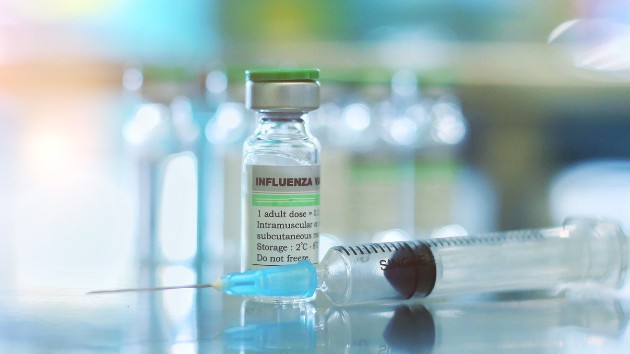By DR. SHIELA BEROUKHIM AFRAHIMI, ABC News
(NEW YORK) — Hospitals across the U.S. are nearing critical capacity due to the rise in COVID-19 cases just as the winter flu season begins to threaten the country. Public officials and doctors worry that the worst is yet to come, but increased rates of flu vaccinations this year may help us avoid a further catastrophic stress on our health care system.The Centers for Disease Control and Prevention’s tracking of flu vaccine distribution over the years shows that so far in the 2020-2021 flu season, 189.4 million flu vaccines have been distributed in the U.S., compared to 174 million in the 2019-2020 season.This, paired with stay-at-home orders, masking and social distancing, means there are fewer cases of the flu this year than ever before. Doctors are noticing less clinic visits and hospital admissions for the flu, and pharmacies are filling fewer prescriptions for Tamiflu, the antiviral medication physicians prescribe for influenza. Data analysts at Walgreens have tracked sales of Tamiflu over the past seven years to estimate flu activity across the U.S., and 2020 has had the lowest Tamiflu sales so far.Flu activity, or incidence of flu cases, in November 2020 was approximately 91% lower than in November 2019, according to the data.Analysts mapped the data, which they call the Walgreens Flu Index, to show via color coordination how heavily each state has been affected by the flu. A time-lapse of the map from the 2019-2020 flu season to the 2020-2021 season shows a dramatic shift from mostly red-colored states (which means high flu activity) to mostly green-colored states (which means low flu activity).”I’ve definitely seen less flu this year,” Dr. Simone Wildes, an infectious disease physician at South Shore Health, told ABC News. “Masks are key for this change, but another reason [for decreased flu] is … we really pushed for a really big campaign this year to get people out to get vaccinated [against the flu] and I think people really heeded our recommendation to take the flu shot this year.”Since earlier this year, experts already assumed we would see less flu activity in the country because flu rates were low in the Southern Hemisphere — where flu season occurs during the summer months — but the low rates may also be a consequence of the social distancing and safety measures that have been taken due to the coronavirus pandemic.”I think it is probably because of the precautions we are taking for COVID-19 and also because of flu shots,” Dr. Krutika Kuppalli, vice chair of the Infectious Disease Society of America, said.Walgreens has also seen an “unprecedented demand … for flu shots this season,” Dr. Kevin Ban, the chief medical officer at Walgreens, said in a written statement to ABC News. “We’ve seen double-digit growth in demand for flu shots this year.”But even as the CDC reports that “flu vaccine coverage has increased for both children and adults over the past flu season,” a great part of the U.S. population has yet to be vaccinated.”Especially in communities of color, there has been a lot of vaccine hesitancy, so a lot of them don’t get the flu vaccine,” Wildes said.But together as a nation, we are moving to address health disparities highlighted during the pandemic.Clinicians “try to engage different disenfranchised communities and patients that we know are at higher risk,” Kuppalli said. “We work on engaging them to understand their concerns when it comes to vaccines.”This year, Walgreens also “implemented the safety precautions needed to administer vaccines in a COVID environment, and rolled out off-site clinics in churches and community centers to ensure access to care for underserved communities,” Ban said.Remember, it’s not too late to get your flu shot this year. And even as the COVID-19 vaccines start rolling out across the country, Wildes said we “absolutely have to continue all of the safety measures” implemented during the pandemic to continue protecting ourselves from both the flu and the novel coronavirus.Copyright © 2020, ABC Audio. All rights reserved.












